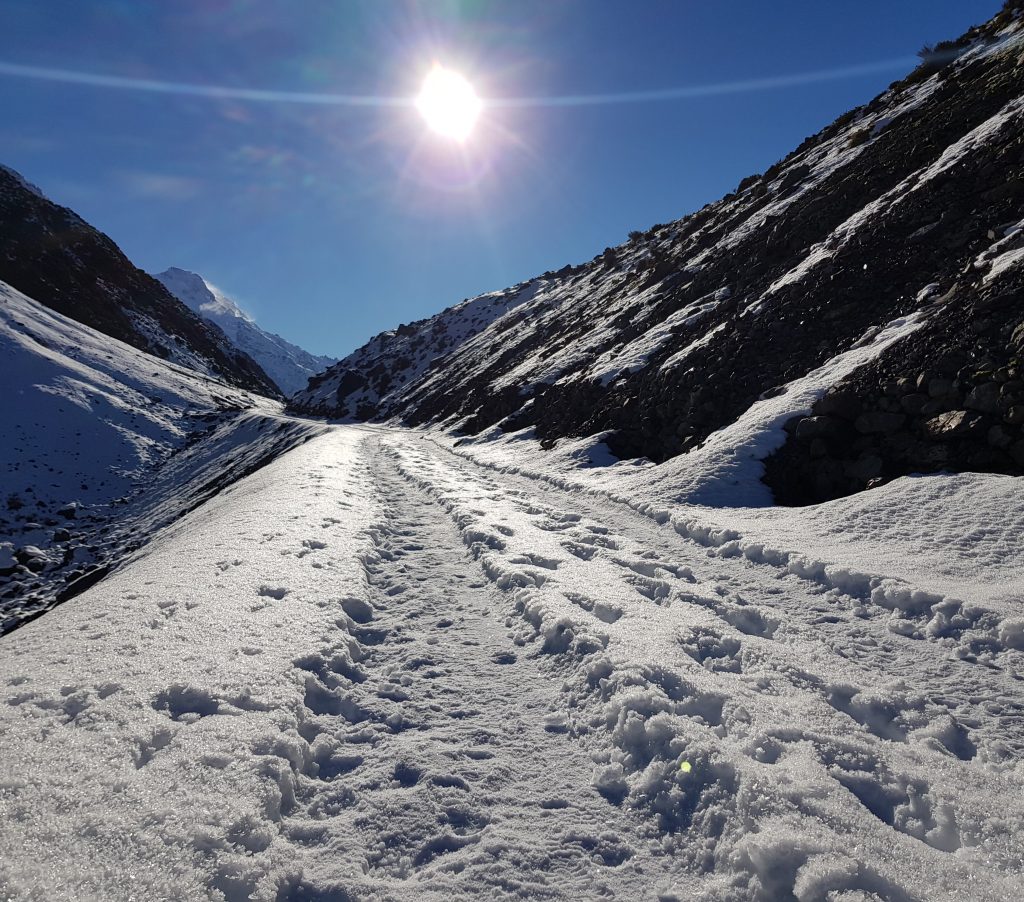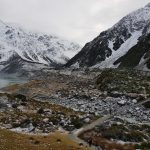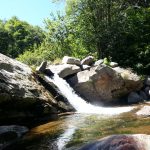Having explored the Hooker Valley and saluted New Zealand’s highest mountain, we emerged from another chilly night in our stubbornly-hitched trailer with a sausage and egg breakfast in mind. While Dad cooked, I eyed up some muscular gentlemen in the dining room. I’m not usually so forward, but I felt that today I should make an exception, so I approached the fellows, put on my most winning smile, and said: “Could you guys give me some help once you’ve finished? Our trailer seems to be stuck on our hitch.”
The gentlemen duly agreed to give it a go and as I walked away I heard a heavily-accented voice whisper: “What’s a trailer?”
Ten minutes later Dad and I and our two white knights were examining the hitch. Gentleman one gave it a try but the thing still wouldn’t budge. Then gentleman two set his prodigious muscles to the task and slowly but surely managed to lever the trailer off our tow bar. With much exultation and words of thanks we sent our heroes on their way.

That meant that we were free to wander where we willed, and I immediately insisted on the raison d’etre for my trip – the Haupapa/Tasman Glacier, largest and longest glacier in Australasia (although Australia doesn’t have any so that’s not really a fair competition). Though I’d been to this area several times before, I don’t believe I’d ever set eyes on the mighty Tasman before – and with its future uncertain I needed to see it now lest I lose the opportunity forever.
We set off carefully down the frost-fringed highway toward the looming mountains ahead. We turned off shortly before reaching Mount Cook Village, following Tasman Valley Road around Hooker Corner (yes, really) toward the heaped moraine of the glacial terminus.
We patiently waited for a pair of paradise ducks to move out of the road before pulling up in the near-deserted car park. My goal was the Ball Shelter track, which runs alongside the Tasman Glacier for 10 or so kilometres to Ball Hut at the confluence of the Ball and Tasman glaciers. I’d originally wanted to walk all the way to the hut and stay the night, but Dad was feeling a little reluctant and the morning’s forecast announcing an approaching winter storm had cooled my ardour for adventure somewhat. I had no desire to be responsible for adding two more names to the alpine memorial, and I was acutely aware of just how dangerous this landscape could be, even on a calm-looking day like this.
So we decided instead on a day walk, and that we would be turning back at the first hint of bad weather. We set off into the bright sunlight, the cloudless sky showing nary a hint of the bad weather that was allegedly on its way. Frosted speargrass, matagouri and tussock bordered the rough vehicle track, while an inch or so of snow clad the cold earth. To our left loomed the Mount Cook Range while to our right a high wall of moraine blocked our view of the glacial lake.

We had barely started before we came across the first avalanche warning sign, cautioning us not to stop in the area. Luckily, winter is the off-season for avalanches and we had checked the risk at the visitor centre the day before – it was comfortingly low.
I had assumed it wouldn’t be far until the moraine levelled out and we’d be able to gaze upon the glacier and its newborn lake in all its glory, however we found ourselves tromping further and further up the valley with no change in sight, save for the snow slowly becoming deeper as we gained altitude.

I eventually got fed up and declared that one way or another I would have my view. I began clawing my way up the steep moraine, trying to find stable footing on the loose rock through several inches of snow. The ridge seemed much higher than it appeared from the ground, and certainly much steeper, but eventually I reached the summit to find that we had almost reached the head of the lake.

Now that the moraine was no longer between myself and the lake, I could hear clearly an eerie refrain of crackles and cracks as the ice on the lake settled in the vibrant sun. Every so often a cascade of pebbles would slide down the unstable slope toward the vast grey lake below.
It is astonishing to reflect that back in 1972 this lake, which exceeds 100m in depth, did not exist at all. The Tasman Glacier, while still New Zealand’s biggest, has retreated 4.5km in the past 25 years. Since the 1990s this has been occurring at an average of 180m per year. If things continue as predicted, in twenty years time the lake will extend another 9km up this valley. Environmental concerns aside, that will be one heck of a walk if I want to see this glacier again when I turn fifty.

I felt that my position atop the moraine was rather perilous, so I picked my way down to rejoin Dad and give him the results of my scouting mission. We continued up the valley, and it did finally seem as if the towering moraine was slowly petering out. However by this time Dad was getting a little tired so I again scrambled up the moraine (slightly easier this time) and discovered we were now above the mighty Tasman.

I bum-shuffled back down to Dad and let him know that it was only another kilometre or so until we’d finally have our unobstructed glacier view. So he agreed to a short distance more so that his walk would not be in vain. Finally, after 6.3km of walking, Dad had his view, and we sat on some rocks overlooking the massive river of ice to take it all in.

While I have been to both the Fox and Franz Josef glaciers, I can honestly say I’ve never before seen anything like this. While those two are very famous (and rightfully so!), there’s simply no easily-accessible and cost-effective way to see them up close like this.
The enormity of what we were seeing is difficult to put in words, and it is mind-blowing to realise that something that seems to so fundamentally represent the awesome power of nature can at the same time be so vulnerable and delicate. What a magnificent sight this must have been back in its prime.
Although Aoraki wasn’t visible from where we were sitting, this place is probably also special in that it is likely to be the nearest I will ever be able to safely get to New Zealand’s highest mountain. I’d happily have stayed longer, but a tiny wisp of cloud visible up the valley suggested we might want to think about returning. So we retraced our steps, at times literally since our footprints were still visible, and returned to our lodgings.
We patiently awaited the alleged storm and sure enough at twilight a gentle snow began to fall. We battened down the hatches on our canvas lodging and hoped that we would not be blown away.
We needn’t have worried as we spent a peaceful night until the light of dawn revealed a pristine snowscape. While the friends and family I left behind in Dunedin (if their many increasingly frantic Facebook posts are to be believed) suffered a miserable few days of wild weather, we’d been treated to a gentle few inches of soft snow with a calm clear day to follow.

We spent our snow day frolicking and exploring, and later enjoying a nice wine in front of the log fire. I was much satisfied with my wintery week away, and I encourage anyone else considering a similar adventure to make plans as soon as feasible.
After all, time goes by quicker than you think and in a few short decades you could lose the opportunity forever.
References:
Tasman Glacier Retreat Update 2013 by Mauri Pelto




Such a charmingly writing!
I was at Mt Cook last weekend but there wasn’t much snow like yours. I was also filled with awe when standing there contemplating the glacier. In fact, I was tempted to go further to the Baller Hut but I ran out of time. I hope I can revisit Mt Cook another day and hope He treats me well with good weather and beautiful soft snow.
Thanks Minh! I saw your pictures on Facebook, they were lovely!
You made it to New Zealand’s largest glacier. Well done!
Couldn’t have done it without you!